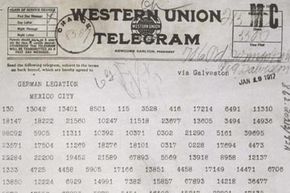By: Colleen Cancio

Have you ever sent a secret message -- perhaps to outsmart an opponent or simply to keep a surprise party under wraps? We all need to send the occasional clandestine communiqué, and a great way to do it is through cryptograms, a type of puzzle that uses letter or number substitutions to hide the meaning of a word or phrase. As long as only the author and intended recipients of the message are privy to the substitution code, its hidden meaning remains a mystery.
Throughout history, cryptograms have been used to protect some of the world's most tightly held secrets. One of the most famous cryptograms is the Zimmerman Telegram, which was sent during World War I by the German foreign minister, Arthur Zimmerman, to the German ambassador to Mexico, Heinrich von Eckhart [source: National Archives]. In it, Zimmerman uses a numeric code to offer Mexico significant portions of U.S. territory in exchange for Mexico's cooperation with Germany against the U.S. The Zimmerman telegram was quickly decoded by the British, and the U.S. entered the war on the side of the Allies just a few weeks later.
Advertisem*nt
There are many different ways to code a message using a cryptogram. One rather simple example is called a substitution cipher, where the letter "A" is substituted for the letter "Z," the letter "B" is substituted for the letter 'Y," and so on through the alphabet [source: Puzzle Baron's Cryptograms]. Another is the Caesar cipher, in which each letter of the alphabet is shifted by a certain number of spaces. For example, using the Caesar cipher with a shift of one space, the word 'DOG' becomes "EPH"' [source: Trinity College].
Traditionally, cryptograms have been used by politicians, spies, lovers, and perhaps some clever teenagers who want to hide their covert conversations from parents' prying eyes. These days they are becoming increasingly common as brainteasers, with an array of Web sites and mobile applications devoted to the solving of cryptograms and cryptoquotes, which are simply cryptograms based on famous quotes [source: Donahue]. In the next section, we explore some of the basic strategies for solving cryptograms.
How to Solve Cryptograms
Solving a cryptogram takes patience, concentration and a bit of strategy. For the latter, you don't have to go it alone. There are as many different approaches to solving cryptograms as there are cryptograms themselves. Start by searching the text for patterns. Are there certain letters that occur more often than others? Identifying them is called frequency analysis, a good first step in solving cryptograms [source: Puzzle Baron's Cryptograms].
As a crypto-sleuth, ETAOIN is your best friend. This is a mnemonic representation of the most common English letters in order of their frequency in the language. This is important to keep in mind. If a letter in a cryptogram appears much more often than others, it's likely that it will decode to one of the letters in ETAOIN, with an even higher probability that it will decode to an "E" or "T."
Advertisem*nt
When solving a cryptogram, focus on the short words first. The English language only has two one-letter words, "I" and "A," so look for single numbers that could be one or the other. Once in a while you may find a cryptogram with the archaic letter "O" (e.g., "O, say can you see…"), but it's rare. Apostrophes are also low-hanging fruit when it comes to solving cryptograms. There are a limited number of choices when it comes to letters that come before and after apostrophes (mainly contractions and possessives), so identifying them is usually easy [source: Puzzle Baron's Cryptograms].
Solving anything longer than three letters in a cryptogram becomes a bit harder. It helps to focus on digraphs, which is where two letters make one sound, such as "CH," "SH," and "TH." By identifying the letter "H" in a cryptogram, you can search for other places where it occurs at the end of a word, which is likely to be another digraph. Double consonants and double vowels also go a long way toward revealing a cryptogram's meaning.
It's important to keep in mind the theme of a cryptogram if one is given by its creator. This almost always gives a clue as to the content of the hidden phrase or quote. These strategies may be enough to crack many of the most common codes -- and perhaps even some of the more obscure ones. But remember that even the most skilled code-crackers spend a lot of time simply gazing at the puzzle and waiting for the hidden message to reveal itself.
Size Matters
Some of the most difficult cryptograms to solve are the shortest ones. That's because it's much easier to spot patterns in a longer string of text [source: Rosen].
Advertisem*nt
Lots More Information
Related Articles
- How KenKen Puzzles Work
- How Chess Puzzles Work
- How 3D Puzzles Work
- How Rebus Puzzles Work
Sources
- Archives.gov. "Teaching with Documents, the Zimmerman Telegraph" (Aug 23, 2011) http://www.archives.gov/education/lessons/zimmermann/
- Boston.com. "Aha! At MIT Mystery Hunt, teams labor to solve elaborate puzzles." (Aug 23, 2011). http://articles.boston.com/2011-01-17/news/29342539_1_crossword-puzzles-aha-moment
- Cryptograms.org. "Frequently Asked Questions." (Aug 19, 2011) http://www.cryptograms.org/faq.php
- Cryptograms.org. "How to Solve a Cryptogram." (Aug 23, 2011) http://www.cryptograms.org/tutorial.php
- Donahue, Kathleen, Owner, Labyrinth Games, personal communication (Aug 19, 2011)
- NationalArchives.org.uk. "Babington Plot." (Aug 19, 2011) http://www.nationalarchives.gov.uk/spies/ciphers/mary/ma2.htm
- National Security Administration "Friedman Legacy, Sources in Cryptographic History." (Aug 23, 2011) http://www.nsa.gov/about/_files/cryptologic_heritage/publications/prewii/friedman_legacy.pdf
- Rosen, David, Avid Puzzler, personal communication (Aug 19, 2011)
- Shugborough.org.uk. "Shugborough Myths and Mysteries." (Aug 19, 2011) http://www.shugborough.org.uk/holy-grail-78
Cite This!
Please copy/paste the following text to properly cite this HowStuffWorks.com article:
Citation
More Awesome Stuff
Advertisem*nt
Advertisem*nt
Loading...
\n\n\t\t\t\t
`;t.byline_authors_html&&(e+=`By: ${t.byline_authors_html}`),t.byline_authors_html&&t.byline_date_html&&(e+="|"),t.byline_date_html&&(e+=t.byline_date_html);var i=t.body_html.replaceAll('"pt','"pt'+t.id+"_");return e+=`\n\t\t\t\t
\n\t\t\t\t
\n\n\t\t\t\t
${i=i.replaceAll("#pt","#pt"+t.id+"_")}
\n\n\t\t\t
`}(a);this.loadedDiv.innerHTML+=n,document.title=a.title+" | HowStuffWorks";let s="content-loaded-"+a.id,l=document.getElementById(s);l.dataset.contentId=a.id;let o=l.querySelectorAll(".lazyload");HSW.utilities.lazyLoadElements(o),HSW.ux.editorial.init({twitter:!0,facebook:!0,instagram:!0}),l.querySelectorAll(".toc a").forEach(t=>{t.addEventListener("click",t=>{t.preventDefault();let e=t.target.dataset.target,i=document.querySelector("a[name='"+e+"']");i?i.scrollIntoView({behavior:"auto"}):console.error("Unable to locate target with name "+e)})});try{if(userData.adsActive)if(HSW.utilities.isMobile()){l.querySelectorAll(".ad-mobinline").forEach(t=>{t.setAttribute("id","ad-wrap-mobinline"+r),t.childNodes[0].setAttribute("id","ad-div-mobinline"+r),void 0!==HSW.ads&&HSW.pq.add(()=>{HSW.ads.addNewUnits(["ad-div-mobinline"+r])},"ads"),r++})}else{let t=document.createElement("div");t.setAttribute("id","ad-after-"+e),t.classList.add("ad-inline","mb-8","bg-gray","w-max-full","h-min-90","text-center");let a=document.createElement("div");a.setAttribute("id","ad-div-inline"+i),t.appendChild(a),l.after(t),void 0!==HSW.ads&&HSW.pq.add(()=>{HSW.ads.addNewUnits(["ad-div-inline"+i])},"ads")}}catch(t){console.error(t)}if(window.setupSinglePageUX(l),history.pushState)try{history.pushState(null,a.title+" | HowStuffWorks",a.href)}catch(t){console.warn(t)}var c=[];a.taxonomy.forEach((t,e)=>{c[e]=t.title.toLowerCase()});var d=c.join("/"),h=[];a.authors.forEach((t,e)=>{h[e]=t.first_name.toLowerCase()+" "+t.last_name.toLowerCase()});var g=h.join(",");pageMetricsData.href=a.href,pageMetricsData.title=a.title,pageMetricsData.tax=d,pageMetricsData.aType=a.asset_type,pageMetricsData.cType=a.type+"-continuous",pageMetricsData.template=a.template,pageMetricsData.source=a.source,pageMetricsData.sponsor=a.sponsor,pageMetricsData.author=g,pageMetricsData.contentid=a.id,pageMetricsData.image=a.hero_image,pageMetricsData.page=0,pageMetricsData.pubDate=a.publish_date.slice(0,10),pageMetricsData.editDate=a.last_editorial_date.slice(0,10);const u=/[^\da-z_]/i;let p=HSW.utilities.isMobile()?"hsw_lite":"hsw";a.taxonomy.slice(1,3).forEach((t,e)=>{p+="|"+t.title.replace(u,"").toLowerCase()}),pageMetricsData.adUnit=p,Alpine.store("share",{title:pageMetricsData.title,url:pageMetricsData.href,image:pageMetricsData.image}),function(t,e){let i=t.href.split(".com/").pop();dataLayer.push({event:"virtual-page-view",virtualPageUrl:i,virtualPageTitle:document.title,pageNbr:0}),dataLayer.push({event:"raw-event-interactive",eventCategory:"page-interaction",eventAction:"continuous-load",eventLabel:"new-content",eventValue:e+1,virtualPageUrl:t.href})}(a,this.items.length);const m={...pageMetricsData};t.items.push(m);for(var f=document.getElementsByClassName("new-content-loaded"),v=0;v